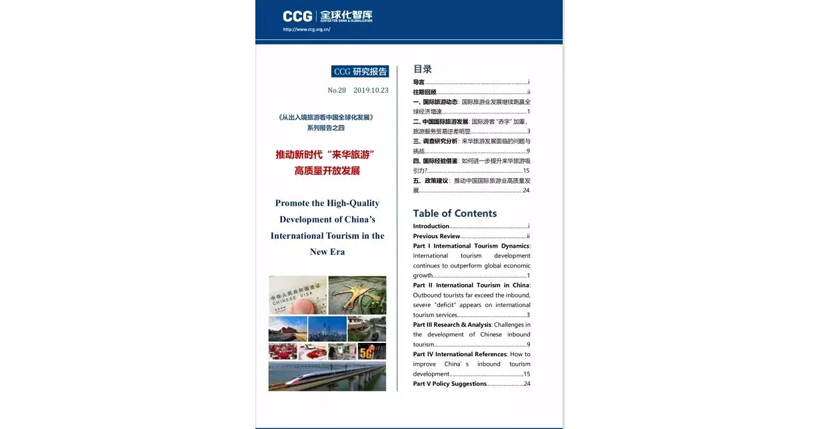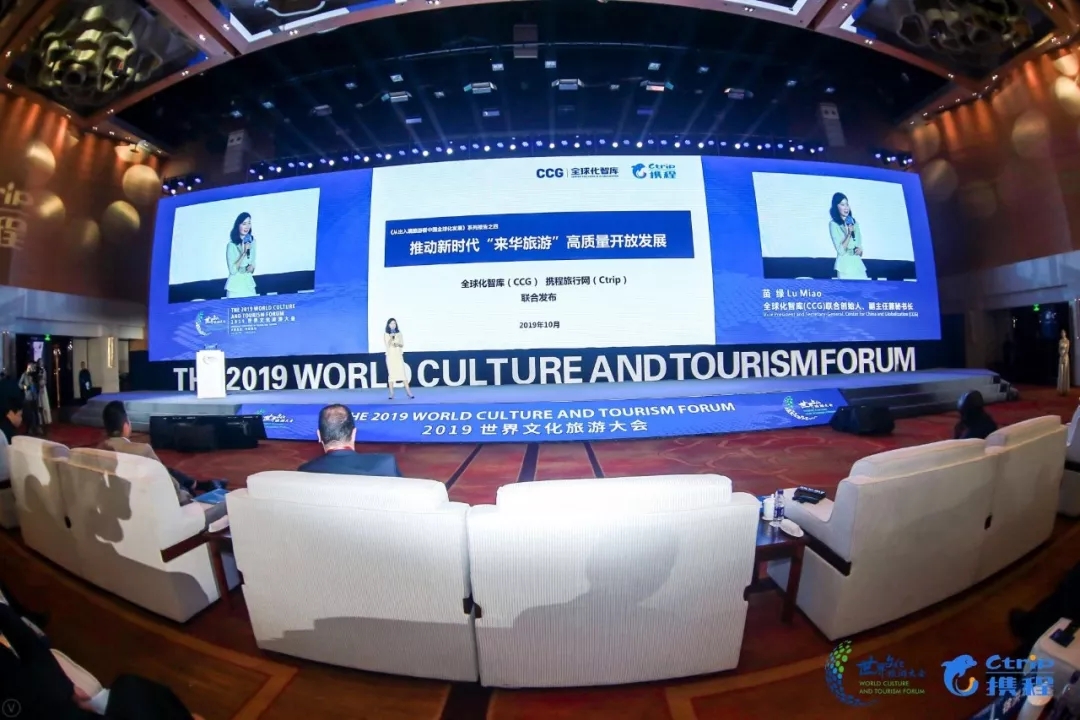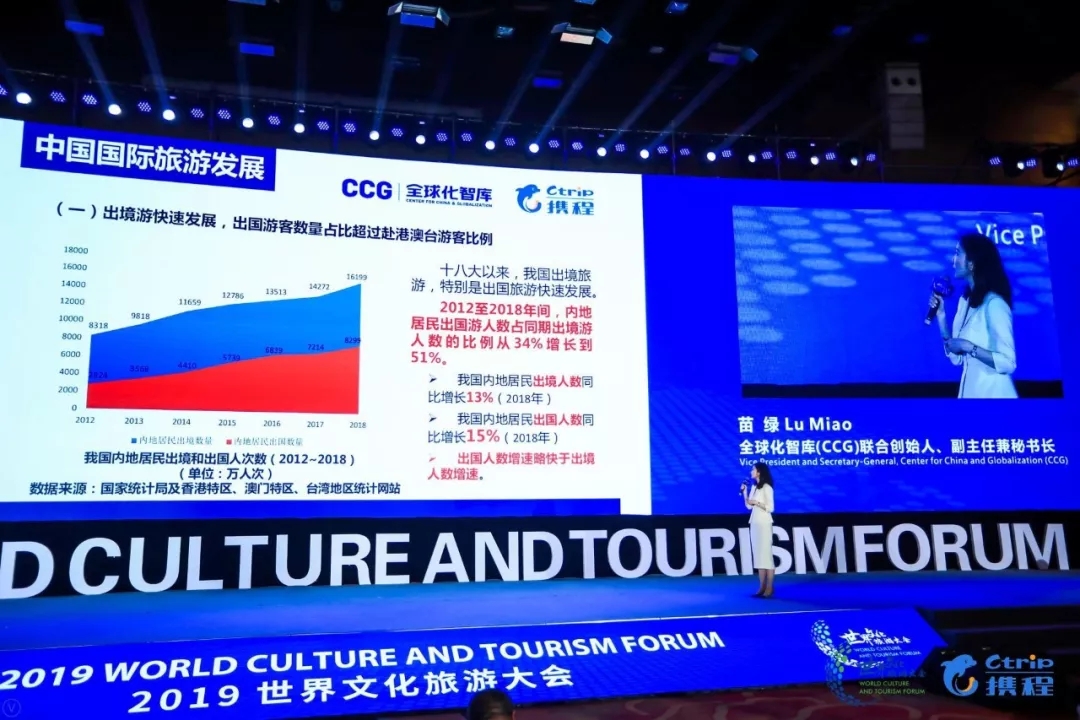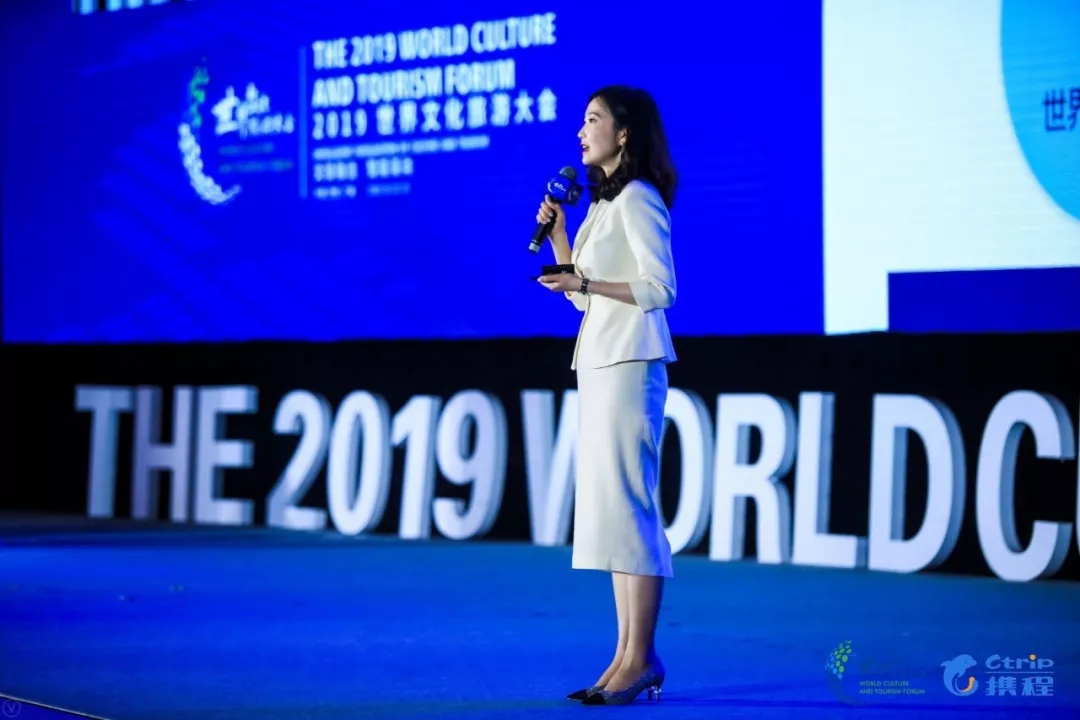CCG release the fourth tourism report at WCTF
October 22 , 2019
From October 22-25, 2019, the 2019 World Culture and Tourism Forum was held in Xi’an, China, under the theme “Integrating Culture and Tourism to Build an Intelligent Future.” More than 1,000 delegates attended the forum, exploring new marketing ideas, destinations and attractions for inbound tourism. The conference hosted by Xi’an Municipal People’s Government and Ctrip.

On October 23rd, Mabel Miao, co-founder and secretary-general of the Center for China and Globalization (CCG) introduced the fourth in a series of reports on tourism and China’s globalization at the forum.
The report, titled “Promote the High-Quality Development of China’s International Tourism in the New Era,” analyzes trends in international tourism and explores the development of international tourism in China. The report highlights challenges and opportunities facing China’s international tourism development. It also suggests several measures to promote the high-quality development of China’s international tourism industry.
Increased outbound tourism and developing inbound tourism
The report pointed out that the proportion of outbound Chinese tourists traveling outside of China increased from 34% to 51%. This shows that going abroad instead of visiting Hong Kong, Macao or Taiwan has become the dominant mode of China’s outbound tourism.
According to the National Bureau of Statistics of China, in 2018, the number of inbound visits to China was 141 million, up 1% year-on-year. The number of foreign tourist arrivals was 30.54 million, accounting for 22% of the total number of inbound tourists, an increase of 5% over the same period of 2017. However, the current growth rate of inbound tourists was lower than several regional average indicators and lower than that of Japan and Thailand. It is clear that China needs more effort into promoting inbound tourism.

China is running the world’s largest tourism deficit
According to the report, the gap between China’s outbound and inbound tourism left China with a tourism deficit of 52.45 million trips in 2018, up by 22% year on year. China’s service trade deficit has now reached USD 239.5 billion.
The report pointed out that the huge tourism deficit in China mainly reflects two problems:
· The statistics of inbound tourists in China include foreigners and visitors from Hong Kong, Macao and Taiwan, and the statistics of destinations of outbound tourists also include foreign countries as well as regions of Hong Kong, Macao and Taiwan.
· The tourism deficit has caused the tourism service trade deficit.
The causes of the tourism trade deficit are various, including the rise of Chinese outbound tourism, Chinese tourists’ shopping habits, and the relatively slow development of inbound tourism in China.
Changing views on China
The research team conducted surveys and in-depth interviews with international tourists visiting China.
It was found that, after visiting China, 82% of the international tourists have shifted their views of China. International tourists were also impressed by innovation in China, such as electronic payments.
However, there are still some challenges for the use of electronic payment by international tourists. For example, WeChat, Alipay and UnionPay are the most popular mobile payment methods in China, but these methods are not commonly used by international tourists. Second, users needed a Chinese bank account to use the Chinese electronic payment platforms, while it is difficult for international tourists to open bank accounts in China.
Ways to improve inbound tourism in China: Visa facilitation and industry innovation
The report proposed that policies regarding visa facilitation and industry innovation could improve inbound tourism in China.
The report pointed out that the developed countries generally adopt a reciprocal policy on visa facilitation, which China can learn from. Accordingly, visa facilitation can be achieved by improving the visa-free system and e-visa application system as well as strengthening cross-border tourism collaboration.
In terms of industry innovation, the report highlighted experiences of international tourism from some representative countries and regions. This included diversifying tourism products, increasing the number of cultural interaction projects, and developing cultural tourism.

Specifically, the report proposed using innovative content to promote the diversification of tourism products, building brands to deepen the exploration of traditional culture and local characteristics, and increasing experiential interactions.
Seven recommendations to promote “Travel to China 2025”
1. Innovate the visa system, establish a visa policy evaluation system and an electronic visa application platform;
2. Strengthen cross-border tourism cooperation with neighboring countries and regions;
3. Improve cultural features of tourism and build a tourism brand with Chinese culture and local characteristics;
4. Enhance tourism promotion and attract tourists with a more market-oriented and localized approach;
5. Enhance and optimize experiential interactions;
6. Strengthen market supervision and the role of industry associations to set standards;
7. Improve tourism talent development, and cultivate and attract development of international tourism professionals.
Participants in the forum included Luis Diego Monsalve Hoyos, Colombian ambassador to China; Edward A.Kwasi Boateng, ambassador of Ghana to China; Mihály BÁRÁNY, deputy state secretary for the EU and International Relations Ministry of Innovation and Technology; James Liang, co-founder and executive chairman of the Board of Ctrip Group; Vinsensius Jemadu, director of International Marketing for Great China of the Ministry of Tourism of Republic of Indonesia; Haybina Hao, regional director of Greater China of WTTC -World Travel & Tourism Council; Baochun Li, executive deputy secretary-general of WTCF; Xiaoan Wei, chief expert of World Tourism Cities Federation and chairman of China Leisure Association; Zhongguang Li, vice president of the China Tourism Academy; Tiger Wu, director and professor of the Peking University Center for Recreation and Tourism Research; Fidan Aliyeva, chief marketing and branding officer Azerbaijan Tourism Board (ATB).
Series of reports on China’s globalization and inbound and outbound tourism
CCG and Ctrip jointly conduct research and produce a series of reports on China’s globalization and inbound and outbound tourism, aiming to explore the core issues of China’s inbound tourism and solutions.
The first report, “Insufficient growth in inbound tourism and China’s tourism deficit” layed out extensive data and thorough analysis of the current situation of China and global tourism. The second report focused on promoting the rapid development of China’s inbound tourism, presenting in-depth research and analysis of international tourist groups. The third report identified key factors affecting tourism development, analyzed the causes, and proposed policy advice to promote tourism-related policy and China’s globalization.






